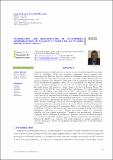| dc.description.abstract | Sugarcane (Saccharum officinarum L.) is known to have microbial organisms associated with its rhizosphere which have potential antagonistic activity against other microorganisms. However numerous studies on rhizosphere microbial diversity have concentrated on other field crops such as rice and wheat. Little attention has been given to sugarcane. The objectives of this study were to enumerate fungi and bacteria in the rhizosphere of sugarcane variety CO 421 and identify the fungi and bacteria within rhizosphere of sugarcane variety CO 421 in Kibos, Kenya Agricultural and Livestock Research Organization – Sugar Research Institute in Kisumu, Kenya. The sugarcane Variety CO 421 was selected for this study because it is widely adapted and grown in all sugarcane growing areas of Kenya. Rhizosphere soil samples were collected randomly from ten fields of the sugarcane variety using a soil auger and trowel into sterile polythene bags. Colonies were isolated from the soil samples in three replicates, following serial dilution and plating techniques on potato dextrose agar for fungi and nutrient agar medium for bacteria. The microbes were identified under a phase contrast microscope, based on their morphological, biochemical characters, taxonomic guides and standard procedures. Data was collected on colony forming units, colony and cell morphological characteristics. Data on microbial count were subjected to analysis of variance. Field means were separated and compared using Fishers Least Significance Difference at p=0.05. Sixteen pure fungal isolates were tentatively identified and four isolates unidentified. Trichoderma was predominant , followed by Aspergillus and then Rhizopus, Penicillium and Alternaria. Twelve pure bacterial isolates were tentatively identified as gram negative bacteria. Pseudomonas was predominant, followed by Bacillus and Azobacter. The study indicated an average population of 1.30×107 cfu/g and 4.88×104 cfu/g bacteria and fungi respectively in the rhizosphere soil samples. | en_US |

